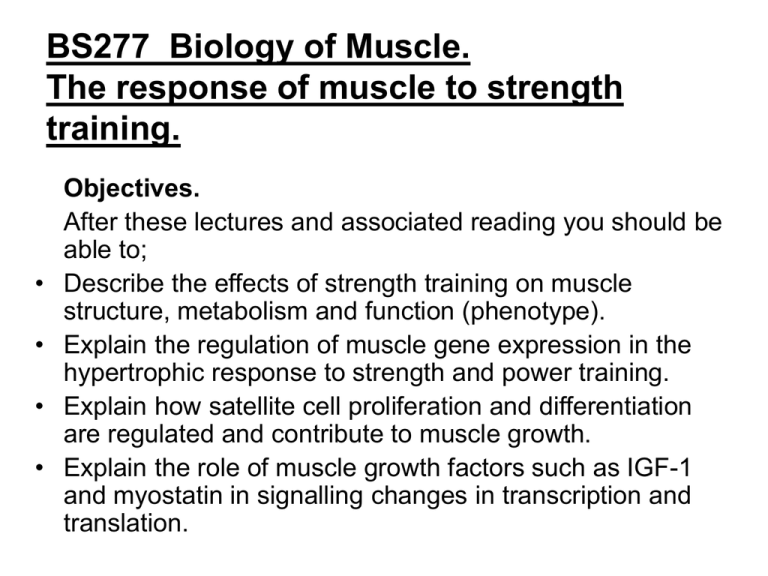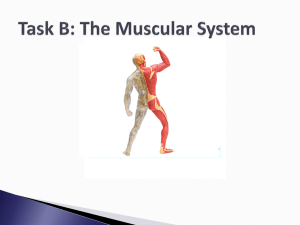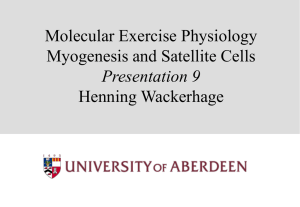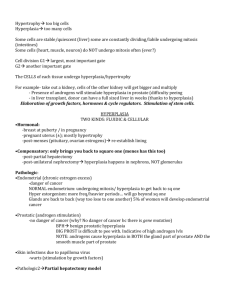BS277 Biology of Muscle. The response of muscle to strength
advertisement

BS277 Biology of Muscle. The response of muscle to strength training. • • • • Objectives. After these lectures and associated reading you should be able to; Describe the effects of strength training on muscle structure, metabolism and function (phenotype). Explain the regulation of muscle gene expression in the hypertrophic response to strength and power training. Explain how satellite cell proliferation and differentiation are regulated and contribute to muscle growth. Explain the role of muscle growth factors such as IGF-1 and myostatin in signalling changes in transcription and translation. Adaptations to resistance training • Muscle fibre size increases (mainly type 2) • No evidence for type 1-2 switch but type 2a might become more type 2X-like in power training. • Capillary density may decrease • Creatine kinase increases • Glycolytic enzymes increase (e.g. PFK) • ATP, CP and glycogen increase • Ligament and tendon strength increase • BMD increases Muscle strength is related to cross sectional area and strength per unit area does not change much during puberty. Total muscle size is subject to a number of influences. Genetic, nutritional and endocrine influence • Number of fibres highly variable (Vastus lateralis 400,000 to 900,000 in 9 cadavers). • Protein synthesis increased for ~48h post resistance training (more in the untrained). • Optimal hypertrophic resonse with mixed meal post training and adequate protein in diet (>0.8 <2 g.kg-1) • Resistance training elevates thyroxine, GH and testosterone (anabolic steroids) and reduces resting cortisol. Improvements in functional strength have a neural as well as a muscular component. Neural contribution to effects of strength training • Unilateral training of elbow flexors in females produced 80% gain in 1RM in trained arm and 9% in contralateral arm (no hypertrophy by anthro.) with similar improvements in rate of force development (40-60%) and peak force (~35%). Adamson et al. (2008) Fig. 1 a Muscle volumes of the trained and untrained arms before (pre-test) and after (post-test) the strength training program, as determined by anthropometry. b 1RM of the trained and untrained arms at pre-test and post-test. *, ** 2-way ANOVA within-group differences between pre-test and post-test. # 1RM increased with a greater magnitude in the trained than the untrained arm The contribution of hypertrophy to strength gains increases with the duration of training. Increases in muscle size are due to hypertrophy, not hyperplasia. Myocyte nuclei are in Go so new nuclei are derived from satellite cells. Contribution of satellite cells to hypertrophy • A 10 cm long muscle fibre may have 412,000 nuclei. • ~109 nuclei in the Vastus lateralis. • 10 weeks of resistance training in women increased satellite cells by 46% and nuclei per muscle fibre by 70%. • Respond to growth factors (upstream signalling pathways not yet known?) Gene expression in satellite cells and myonuclei might be influenced by signals associated with strength training. What is the nature of the hypertrophic signal? • Swelling (osmotic effect of metabolites) increases amino acid transport, perhaps via an integrin mediated signal (co-ordinates anabolic effect?) • Tension activation of titin kinase? Integrins via cytoskeleton? • Muscle damage? But not always associated with hypertrophy (e.g marathon runners). • Calcium? Increases specifically in recruited motor units. Type 2 might be more susceptible to a Ca++-related anabolic signal. Muscles can respond to strength training even in the elderly. (5x 68y males. Elbow flexors, 12 weeks training) Roman et al. (1993) JAP 74, 750-754. The hypertrophic response is mainly in type 2 fibres. What is the diameter of a hypertrophied type 2 fibre? (If SA = 6000 then D = 88µ. If SA = 8000 then D = 101µ i.e. a 13% increase in diameter produces a 33% increase in area / volume) Amplitude and latency of Motor unit recruitment & Tendon reflex following resistance training. (Indications that the Alphamotoneurones become more excitable; latency shortens,tendon reflex quicker(?), EMG amplitude increases)











